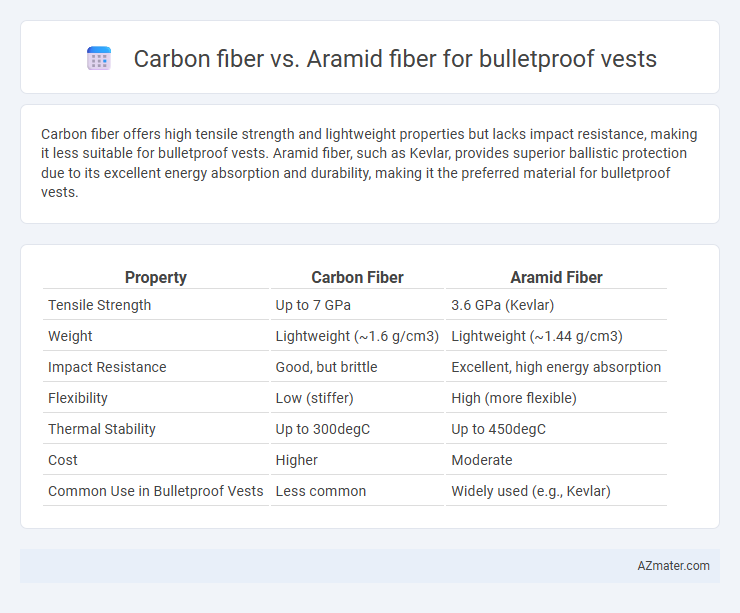Carbon fiber offers high tensile strength and lightweight properties but lacks impact resistance, making it less suitable for bulletproof vests. Aramid fiber, such as Kevlar, provides superior ballistic protection due to its excellent energy absorption and durability, making it the preferred material for bulletproof vests.
Table of Comparison
| Property | Carbon Fiber | Aramid Fiber |
|---|---|---|
| Tensile Strength | Up to 7 GPa | 3.6 GPa (Kevlar) |
| Weight | Lightweight (~1.6 g/cm3) | Lightweight (~1.44 g/cm3) |
| Impact Resistance | Good, but brittle | Excellent, high energy absorption |
| Flexibility | Low (stiffer) | High (more flexible) |
| Thermal Stability | Up to 300degC | Up to 450degC |
| Cost | Higher | Moderate |
| Common Use in Bulletproof Vests | Less common | Widely used (e.g., Kevlar) |
Introduction: Carbon Fiber vs Aramid Fiber in Bulletproof Vests
Carbon fiber and aramid fiber, such as Kevlar, are two prominent materials used in bulletproof vests, each offering distinct protective properties. Carbon fiber excels in rigidity and impact resistance, making it suitable for lightweight ballistic plates, while aramid fiber provides excellent tensile strength and flexibility, allowing for effective energy absorption and enhanced wearer mobility. Choosing between carbon fiber and aramid fiber depends on the specific threat level, weight preferences, and comfort requirements in ballistic armor design.
Material Composition and Structure
Carbon fiber consists of tightly woven carbon filaments arranged in a rigid lattice, offering exceptional tensile strength and lightweight properties ideal for bulletproof vests. Aramid fiber, made from long-chain synthetic polyamides like Kevlar, features a high-strength molecular structure with excellent flexibility and impact resistance. The differing material composition and crystalline structure result in carbon fiber providing superior stiffness and durability, while aramid fibers excel in energy absorption and multi-hit protection.
Ballistic Protection Performance
Carbon fiber offers excellent tensile strength and rigidity, but its ballistic protection performance is generally inferior to aramid fiber in bulletproof vests due to lower energy absorption and impact dispersion capabilities. Aramid fiber, such as Kevlar, provides superior ballistic resistance by effectively absorbing and distributing the kinetic energy of projectiles, significantly reducing penetration and trauma. The lightweight and flexible nature of aramid fiber enhances wearer mobility and comfort while maintaining higher standards of personal protection compared to carbon fiber composites.
Weight and Comfort Comparison
Carbon fiber offers a significant weight advantage over aramid fiber, making bulletproof vests lighter and less cumbersome for extended wear. Its high stiffness and low density contribute to increased comfort by reducing strain and allowing better mobility. In contrast, aramid fibers, while strong and impact-resistant, tend to be heavier and less flexible, which can lead to reduced comfort during long-term use.
Durability and Wear Resistance
Carbon fiber offers superior durability and exceptional wear resistance, making it highly effective in maintaining structural integrity under impact and abrasion. Aramid fiber, known for its outstanding tensile strength and flexibility, provides excellent durability but can degrade faster under prolonged UV exposure and repeated friction. Both materials enhance bulletproof vest performance, but carbon fiber excels in long-term wear resistance, while aramid fiber balances durability with lightweight comfort.
Flexibility and Mobility
Carbon fiber offers superior stiffness and strength but tends to be more rigid, potentially limiting flexibility and mobility in bulletproof vests. Aramid fiber, such as Kevlar, provides greater flexibility and lightweight comfort, allowing for enhanced movement and better wearer agility. The balance between protection and mobility in bulletproof vests often favors aramid fiber due to its ability to conform to body contours without sacrificing ballistic resistance.
Environmental and Chemical Resistance
Carbon fiber offers superior chemical resistance compared to aramid fiber, displaying excellent durability against solvents, acids, and alkalis, which enhances the longevity of bulletproof vests in harsh chemical environments. Aramid fiber, while providing robust impact resistance, tends to degrade over time when exposed to UV light, moisture, and certain chemicals, limiting its environmental resilience. Choosing carbon fiber for bulletproof vests ensures better performance in chemically aggressive and humid conditions, promoting longer service life and reduced maintenance.
Cost and Availability
Carbon fiber bulletproof vests generally cost more than aramid fiber variants due to complex manufacturing processes and higher material expenses. Aramid fibers like Kevlar are widely available and have established supply chains, making them a more cost-effective option for mass production. The balance between affordability and performance often favors aramid fiber in widespread protective gear applications.
Applications in Law Enforcement and Military
Carbon fiber's high tensile strength and lightweight characteristics make it ideal for bulletproof vests used in law enforcement and military applications that require enhanced mobility and durability. Aramid fiber, such as Kevlar, offers superior energy absorption and resistance to ballistic impacts, making it the preferred choice for body armor designed to stop high-velocity projectiles and shrapnel. Combining carbon fiber with aramid fiber can optimize protection by balancing rigidity and flexibility, meeting the diverse demands of tactical environments.
Future Trends in Bulletproof Vest Materials
Emerging trends in bulletproof vest materials emphasize combining carbon fiber's exceptional strength-to-weight ratio with aramid fiber's superior energy absorption and flexibility to enhance overall protection and comfort. Researchers are developing hybrid composites that leverage carbon fiber's rigidity for ballistic resistance and aramid's high tensile strength to improve multi-hit capability and durability. Advancements in nanotechnology and fiber treatment coatings aim to further optimize these materials for lighter, more effective bulletproof vests adaptable to diverse threat levels.

Infographic: Carbon fiber vs Aramid fiber for Bulletproof vest
 azmater.com
azmater.com